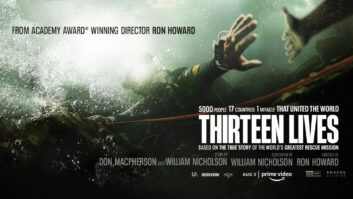Surprises are the last things mixer Lee Dichter wants to hear when he sits down to start working on a feature, yet that’s just what he got when he started mixing The Score. The good news was that it was all good news. “I am very happy with the way the soundtrack ended up,” he says from the Sound One dub stage in New York. “There was very little looping, amazingly little. I think the least amount of looping on a film that I’ve worked on, except for a Woody Allen film, who does no looping.”
Dichter credits location sound recorder Glen Gauthier for the stellar production tracks. Gauthier used a Nagra D to record on location.
Of course, that didn’t mean that Dichter didn’t have his hands full with other sonic issues. The biggest was the fact that he had to mix a combination of lavalier and boom mics, because main character Marlon Brando did not want to be wired. The film’s other main characters, Ed Norton and Robert DeNiro, used lavaliers. “So, all of [Brando’s] scenes were being picked up by a boom microphone,” Dichter explains. “That made it very interesting on my end, because I had to marry the wireless sound with the boom sound. It’s a different tonality and equalization curve, and some of the scenes were difficult to make seamless at the end of the mix. It worked out fine, but it was a challenge.”
Dichter made it work by using equalization and what he calls “roomizing” the lavalier tracks. “We did have a distant boom mic, but I usually didn’t use that, because the pickup was too far away,” he says. “So I ended up going with the lavalier on DeNiro and Norton and putting them through a half-second to a quarter-second Lexicon stereo delay to match the sound of the microphones from Brando. It worked out pretty well. I don’t think you’ll be able to pick up on where the shifts happen.”
One of the most challenging scenes he had to work on was also one of the movie’s most important. The scene takes place in the basement of Brando’s home. “He’s got a swimming pool that’s empty because it’s under renovation, and he’s 20 to 30 feet away from the camera with a boom picking him up,” Dichter explains. “They kept cutting in to close-ups, and eventually DeNiro and him come together. That was a quite interesting use of different microphones and different sound space. Fortunately, I had that distance to work with visually, so you could live with the reverb and the echo. As they got closer, we kept some of that going so you wouldn’t be jarred by long shot, medium shot, close-up, even though I’m cutting from a long shot to close-up.”
Though much of The Score takes place inside, the few street scenes in the film enabled Dichter to enact his dialog cleaning philosophy, which boils down to less is more. “I really hate to use those things,” he says of compressors and filters. “Any piece of outboard equipment that you can hear, I hate it. I’d rather you hear the background pulsing than to shut down the sound between words. It just takes me out of it, so I try to minimize when it comes to lowering background tones.”
Indeed, the only filtering he uses removes set noise from cameras and equipment buzz. “In most of the dialog scenes I work with in any film, my technique is to use the least amount of filters and background suppressors, because I don’t like what it does with the voice. I’d rather live with more of the background, but with a fuller, natural sound to the dialog,” he says.
In the final analysis, Dichter adds, these days, films are a sonic smorgasbord. The Score was no different. “The film is a great combination of a musical score by Howard Shore, the effects design and mixing, and the dialog mixing,” Dichter says. “Each one needs the other for support. The dialog just sits there by itself with nothing else going on. It doesn’t come to life until you bring the effects in, and the tension in the scene is increased tremendously when you get the right music score behind it. So it’s all a combination.”







